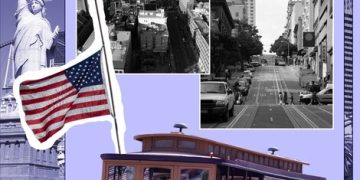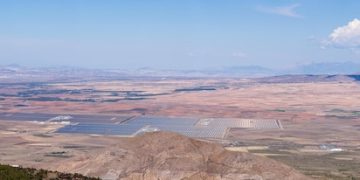Analyzing Regional Disparities in US Economic Growth

Analyzing the regional disparities in economic growth across the US involves examining variations in economic performance among different regions, influenced by factors like industry specialization, demographics, and policy decisions, highlighting areas of prosperity and those facing challenges.
The United States, a nation celebrated for its economic prowess, presents a complex tapestry of regional economies. **Analyzing the regional disparities in economic growth across the US** reveals a diverse landscape where some areas flourish while others struggle, highlighting the need for targeted strategies to foster balanced prosperity.
Understanding Regional Economic Disparities
Regional economic disparities refer to the significant differences in economic indicators, such as income, employment, and growth rates, among various geographic areas within a country. In the US, these disparities are driven by a combination of historical, structural, and policy-related factors.
Historical Context
The roots of regional economic disparities in the US can be traced back to historical events and policies that shaped the country’s economic geography. Industrialization, for instance, concentrated wealth and employment in certain regions, while others were left behind.
Structural Factors
Structural factors, such as industry specialization and demographic shifts, also play a crucial role. Regions heavily reliant on declining industries or experiencing population loss often face significant economic challenges.

Policy Impacts
Government policies, including tax incentives, infrastructure investments, and regulatory frameworks, can either exacerbate or mitigate regional economic disparities. Understanding these policy impacts is essential for developing effective solutions.
- Industry specialization: Diversifying regional economies can buffer against industry-specific shocks.
- Demographic shifts: Addressing the needs of aging populations and attracting younger workers can boost regional economies.
- Infrastructure investment: Strategic investments in transportation, communication, and energy infrastructure can improve regional competitiveness.
In conclusion, understanding these disparities is crucial for crafting policies that promote inclusive and sustainable economic growth across the entire nation.
Measuring Economic Disparities
Measuring economic disparities involves using various economic indicators to compare the performance of different regions. These indicators provide insights into the magnitude and nature of the disparities, helping policymakers target their interventions effectively.
Gross Domestic Product (GDP)
GDP is a key measure of a region’s economic output. Comparing GDP per capita across regions reveals differences in productivity and living standards.
Employment Rates
Employment rates indicate the proportion of the labor force that is employed. Significant differences in employment rates can signal underlying economic problems in certain regions.
Income Levels
Income levels, including median household income and per capita income, reflect the economic well-being of residents. Disparities in income levels often correlate with differences in education, skills, and job opportunities.

Poverty Rates
Poverty rates measure the percentage of the population living below the poverty line. High poverty rates in certain regions indicate a lack of economic opportunity and social mobility.
- GDP per capita: High GDP per capita often indicates strong economic activity and high productivity.
- Employment rates: Low employment rates can lead to decreased consumer spending and economic stagnation.
- Income levels: Higher income levels generally translate to better health outcomes and higher quality of life.
In summary, measuring economic disparities through these indicators provides a comprehensive understanding of the economic landscape and informs policy decisions aimed at reducing inequality.
Factors Contributing to Regional Disparities
Several factors contribute to regional disparities in economic growth. These factors range from industry structure and human capital to technological innovation and access to capital.
Industry Structure
Regions with a diversified industry base are generally more resilient to economic shocks than those heavily reliant on a single industry. The decline of manufacturing in the Rust Belt, for example, led to significant economic challenges.
Human Capital
The quality of human capital, including education and skills, is a critical determinant of regional economic growth. Regions with highly educated and skilled workforces tend to attract high-wage industries and innovative firms.
Areas with better education and skills tend to attract high-wage industries that innovate.
Technological Innovation
Technological innovation drives productivity growth and creates new economic opportunities. Regions with strong research universities and entrepreneurial ecosystems are more likely to foster innovation and attract venture capital.
Access to Capital
Access to capital is essential for businesses to invest, expand, and create jobs. Regions with well-developed financial markets and access to venture capital tend to experience faster economic growth.
In conclusion, a multifaceted approach is needed to address the various factors that contribute to these disparities.
The Impact of Federal Policies
Federal policies wield considerable influence over economic dynamics across US regions, with their impacts felt distinctly in areas such as infrastructure, education, and tax incentives.
Infrastructure Investments
Federal investment in infrastructure upgrades, including transport networks and energy grids, is vital in connecting regions, facilitating commerce, and improving productivity.
Education Funding
Federal support for educational initiatives, ranging from early childhood programs to post-secondary education, shapes the quality of the workforce and affects chances for economic advancement.
Tax Incentives
Federal tax policies, featuring incentives for business investment and employment, can potentially impact regional job formation and economic expansion.
The efficacy of these policies hinges on factors such as resource distribution, implementation strategies, and alignment with regional requirements.
Evaluating these policies is key to maximizing their effectiveness in mitigating regional gaps.
Strategies for Reducing Regional Disparities
To effectively address regional disparities and cultivate equitable economic advancement throughout the US, comprehensive strategies tailored to regional necessities are indispensable.
Investing in Education and Human Capital
Bolstering educational resources and promoting skills development in underserved regions empowers individuals and bolsters economic productivity, attracting opportunities for growth.
Promoting Innovation and Entrepreneurship
Cultivating innovation hubs and assisting budding entrepreneurs can generate employment and spur economic expansion, revitalizing local economies.
Infrastructure Development
Targeted investment in infrastructure improvement is essential for fostering better connectivity and driving economic output, ensuring balanced development across regions.
In summary, effectively tackling regional disparities necessitates coordinated initiatives that support education, innovation, and infrastructure, creating more competitive and prosperous areas.
Case Studies of Regional Economic Development
Examining success stories in regional economic development offers valuable insights for policymakers and stakeholders, providing insights into effective strategies and impactful results.
The Transformation of Pittsburgh
Pittsburgh’s transition from a steel manufacturing hub to a technology and healthcare center demonstrates the potential for economic diversification and resilience.
The Growth of the Research Triangle in North Carolina
The Research Triangle’s development as a hub for research, innovation, and high-tech industries highlights the importance of collaboration between universities, businesses, and government.
The Revitalization of Austin, Texas
Austin’s emergence as a center for technology, music, and culture showcases the power of attracting talent, fostering creativity, and building a vibrant ecosystem.
In conclusion, embracing innovation and creating vibrant environments can fuel economic expansion across regions.
| Key Point | Brief Description |
|---|---|
| 📊 Measuring Disparities | GDP, employment, income levels and poverty rates reveals magnitude and nature of disparities. |
| 🏭 Industry Structure | Diversification can buffer against industry-specific shocks, offering resilience. |
| 🎓 Human Capital | Education and skills attract high-wage industries and spur innovation. |
| 🏛️ Federal Policies | Influence infrastructure, education, and tax to impact economic growth. |
Frequently Asked Questions (FAQ)
▼
Regional economic disparities refer to significant differences in economic indicators, such as income and employment, among various geographic areas within a country, reflecting uneven economic development.
▼
They arise from a mix of historical events, like industrial shifts, structural factors such as industry specializations, and variations in government assistance and policies across state lines.
▼
Economic disparities are gauged by assessing GDP per capita, employment rates, median household income, and poverty rates to understand regional economic well-being and development levels.
▼
The US government employs infrastructure and education for regional development alongside tax incentives for businesses to generate job growth in disadvantaged regions.
▼
Success stories include Pittsburgh’s shift to tech, the North Carolina Research Triangle high-tech industry, and Austin, Texas attracting high-growth tech sectors and culture, with growing economy.
Conclusion
In conclusion, addressing regional disparities in US economic growth requires a multifaceted approach that considers historical context, structural factors, and policy impacts. By measuring these disparities, understanding their causes, and implementing targeted strategies, we can work towards a more equitable and prosperous future for all regions of the United States.





